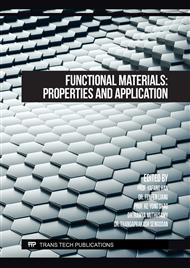[1]
Kozlov P N. Assessing the fatigue strength of structural materials by assuming equivalence of a complex stress state and simple extension. Review of Experimental Data and Preliminary Analysis[J]. Russian Engineering Research, 2022, 41(12):1145-1148.
DOI: 10.3103/s1068798x2112025x
Google Scholar
[2]
Hong J Z, Song S X, WANG J F, et al. Effect of Nb-Mo microalloying on microstructure and mechanical properties of δ-TRIP steel [J]. Heat Treatment of Metals, 2019, 44(5): 1-6.
Google Scholar
[3]
Shiri S G, Jahromi S A J, Palizdar Y, et al. Unexpected effect of Nb addition as a microalloying element on mechanical properties of δ-TRIP steels [J]. Journal of Iron and Steel Research International, 2016, 23(9): 988-996.
DOI: 10.1016/s1006-706x(16)30148-0
Google Scholar
[4]
Yi H L, Chen P, Wang G D, et al. δ-TRIP steel: Physical and mechanical metallurgy [J]. Engineering Sciences, 2014, 16(2): 18-30.
Google Scholar
[5]
Delagnes D, Lamesle P, Mathon M H, et al. Influence of silicon content on the precipitation of secondary carbides and fatigue properties of a 5%Cr tempered martensitic steel[J]. Materials Science & Engineering A, 2018, 394(1-2):435-444.
DOI: 10.1016/j.msea.2004.11.050
Google Scholar
[6]
Richman R H, Landgraf R W. Some effects of retained austenite on the fatigue resistance of carburized steel[J]. Metallurgical Transactions A, 1975, 6(5):955.
DOI: 10.1007/bf02661347
Google Scholar
[7]
Peterson R E. The role of stress distribution in fatigue [J]. Experimental Mechanics, 1961, 1(4): 105-115.
Google Scholar
[8]
Lei B M, Tran V, Taheri S, et al. Effects of biaxial mean stress on the critical plane orientation under biaxial tension/compression fatigue loading conditions [J]. International Journal of Fatigue, 2014, 66: 194-206.
DOI: 10.1016/j.ijfatigue.2014.04.004
Google Scholar
[9]
Ida Y. Stress concentration and unsteady propagation of longitudinal shear cracks [J]. Journal of Geophysical Research, 1973, 78(17): 3418-3429.
DOI: 10.1029/jb078i017p03418
Google Scholar
[10]
González-Doncel G, Torralba M, Ruano O A. Fracture of Al-4%Cu-0.1%Fe single crystals [J]. Journal of Materials Science, 1989, 24(7): 2594-2602.
DOI: 10.1007/bf01174531
Google Scholar
[11]
Bezensek B, Hancock J W. The re-characterisation of complex defects - Part I: Fatigue and ductile tearing [J]. Engineering Fracture Mechanics, 2004, 71(7-8): 981-1000.
DOI: 10.1016/s0013-7944(03)00155-3
Google Scholar
[12]
Yagi J, Tomita Y, Fujimoto Y, et al. Studies on the fatigue crack propagation rate (2nd Report) [J]. Rare Metal Materials & Engineering, 2009, 1981(149): 250-259.
DOI: 10.2534/jjasnaoe1968.1981.250
Google Scholar
[13]
Predan J, Gubeljak N, Fischer F D, et al. Prediction of the growth rate and propagation direction of fatiguecracks with the configurational forces model [J]. Knowledge-Based Systems, 2009, 37(2): 211-229.
Google Scholar
[14]
Mcauliffe C, Waisman H. A unified model for metal failure capturing shear banding and fracture [J]. International Journal of Plasticity, 2015, 65: 131-151.
DOI: 10.1016/j.ijplas.2014.08.016
Google Scholar



